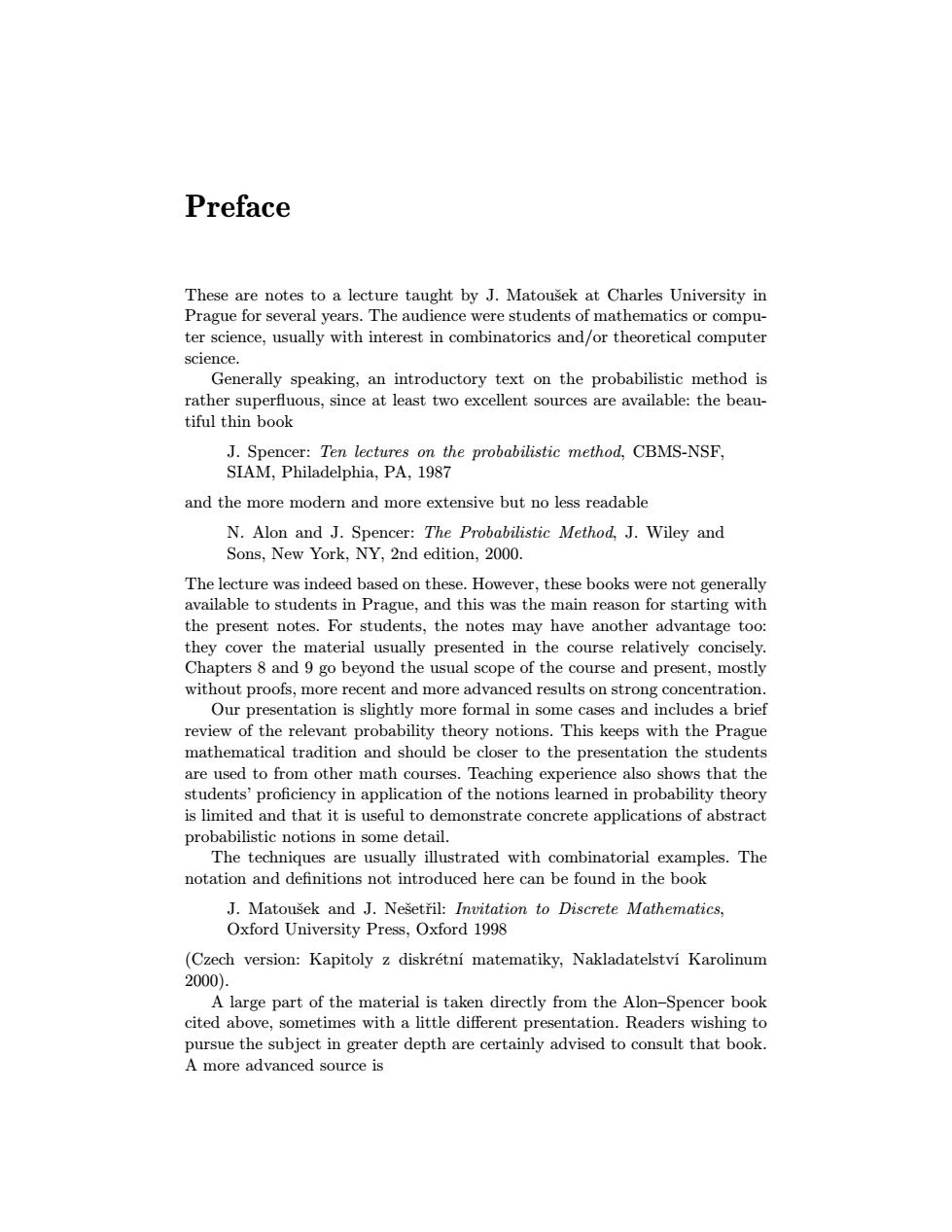正在加载图片...

Preface These are notes to a lecture taught by J.Matousek at Charles University in Prague fors rs The ere students of mathe ter science,u Generally speaking.an introductory text on the probabilistic method is rather ous,since at least two excellent sources are available:the be J.Spencer:Ten lectures on the probabilistic method,CBMS-NSF, SIAM,Philadelphia,PA,1987 and the more modern and more extensive but no less readable N.Alon and J.Spencer:The Probabilistic Method,J.Wiley and Sons,New York,NY,2nd edition,2000. The lecture was indeed based on these.However,these books were not generally available to students in Prague,and this was the main reason for starting with the present notes.For students,the notes may have another advantage too: they cover the material usually presented in the course relatively concisely. Chapters 8 and 9 go beyond the usual scope of the course and present,mostly without proofs,more recent and more advanced results on strong concentration Our presentation is slightly more formal in some cases and includes a brief review of the relevant probability theory notions.This keeps with the Prague mathematical tradition and should be closer to the presentation the students are used to from other math courses.Teaching experience also shows that the students'proficiency in application of the notions learned in probability theory is limited and that it is useful to demonstrate concrete applications of abstract probabilistic notions in some detail. The techniques are usually illustrated with combinatorial examples.The notation and definitions not introduced here can be found in the book J.Matousek and J.Nesetril:Invitation to Discrete Mathematics, Oxford University Press,Oxford 1998 (Czech version:Kapitoly z diskretni matematiky,Nakladatelstvi Karolinum 2000). A large part of the material is taken directly from the Alon-Spencer book cited above,sometimes with a little different presentation.Readers wishing to pursue the subject in greater depth are certainly advised to consult that book. A more advanced source isPreface These are notes to a lecture taught by J. Matoušek at Charles University in Prague for several years. The audience were students of mathematics or computer science, usually with interest in combinatorics and/or theoretical computer science. Generally speaking, an introductory text on the probabilistic method is rather superfluous, since at least two excellent sources are available: the beautiful thin book J. Spencer: Ten lectures on the probabilistic method, CBMS-NSF, SIAM, Philadelphia, PA, 1987 and the more modern and more extensive but no less readable N. Alon and J. Spencer: The Probabilistic Method, J. Wiley and Sons, New York, NY, 2nd edition, 2000. The lecture was indeed based on these. However, these books were not generally available to students in Prague, and this was the main reason for starting with the present notes. For students, the notes may have another advantage too: they cover the material usually presented in the course relatively concisely. Chapters 8 and 9 go beyond the usual scope of the course and present, mostly without proofs, more recent and more advanced results on strong concentration. Our presentation is slightly more formal in some cases and includes a brief review of the relevant probability theory notions. This keeps with the Prague mathematical tradition and should be closer to the presentation the students are used to from other math courses. Teaching experience also shows that the students’ proficiency in application of the notions learned in probability theory is limited and that it is useful to demonstrate concrete applications of abstract probabilistic notions in some detail. The techniques are usually illustrated with combinatorial examples. The notation and definitions not introduced here can be found in the book J. Matoušek and J. Nešetřil: Invitation to Discrete Mathematics, Oxford University Press, Oxford 1998 (Czech version: Kapitoly z diskrétní matematiky, Nakladatelství Karolinum 2000). A large part of the material is taken directly from the Alon–Spencer book cited above, sometimes with a little different presentation. Readers wishing to pursue the subject in greater depth are certainly advised to consult that book. A more advanced source is